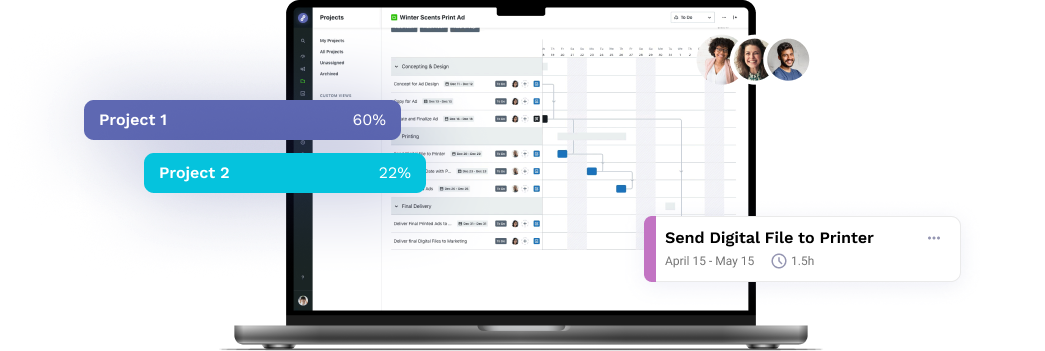
The Importance of Strong Employer Branding
If you want to recruit and retain the most talented people, you need to build and employer brand that is seen as an ’employer of choice’ rather than one out of many possible employers. In other words – you need to stand out from the crowd. And that’s where employer branding comes in.
What Is an Employer Brand?
Your employer brand reflects how professionals perceive you in the job market. It’s your company’s reputation in the eyes of potential candidates and existing employees. It helps employers attract the best talent and retain it.
Gone are the days when you’d post a job opening that would receive an overflow of perfectly suitable applicant CVs. These days, HR and recruitment are tasked with making their employers attractive to candidates. They do so by marketing the company to the right potential fits, by exciting professionals about the prospect of working there.
But what exactly is employer branding? Every business has an employer brand, whether it’s intentionally constructed or not. An employer brand is a facet of your larger brand identity, aimed at potential new coworkers.
A brand is created out of the core idea or purpose of a company and the tangible, visual representations of that idea. It manifests itself through the four vectors of product, environment, communication and behavior. The behavioral aspect is paramount to employer branding, as it relates to how people in your organization relate and behave to each other, and to external stakeholders.
How Do You Develop an Employer Branding Strategy?
There are certain steps you need to take to create a strong employer brand.
- Know your audience and with which channels to reach them
- Create and launch a great careers site with a user-friendly application process
- Provide detailed job descriptions to maximize transparency
- Infuse your company culture into your job descriptions and communications
- Work on an exceptional social media presence
What Makes an Employer Brand Great?
Work culture is what employees do and how they behave when no one is watching. The same principle goes for your employer brand. You can’t make it up. And just because you list some values, like being brave or we value innovation in your employee guide, this doesn’t mean these things are true. There are three basic strategy tiers that all great employer brands have in common.
1. Values
We don’t mean generic sentences listed on your about us page. Rather, you must ensure your company is striving for more than just pure profit if you wish people to perceive you as a great employer brand. Now, think of Tony Chocolonely and Innocent Drinks. Do they want to expand and make a profit? Sure, they do and, next to that, they’re fighting to abolish slavery and raise awareness on issues of social injustice and criminal labor malpractices.
2. Benefits
Most people work for the money and benefits that come with a job. However, part of our reasoning for doing so is not tied to finances. While some great employer brands are small and can’t compete with salaries and bonuses, they can offer a greater work-life balance, a remote-first setting, flexible hours, permanent contracts, and more breaks.
3. Practices
Then, companies with great employer brands practice what they preach. That is, they set their employees up for success and provide them with opportunities to learn, grow, and explore their interests. Such great employers give people the tools they need to execute their roles to the best of their abilities. Finally, they avoid micromanaging, and they make clear, strategic, and transparent decisions.
In the list of examples outlined below, we’ll look at companies whose employees work in junior positions, on minimum wage. The work is repetitive and physical – still, employees rank their employer well. How have they achieved this? Employees:
- Are trained well, with a personal development plan in place
- Respect and are respected by their company and colleagues
- Have goals to work towards that matter to them and their employer
Top Employer Branding Examples
Patagonia
Why is Patagonia such a popular employer? Patagonia is a prime example of a company that shines through its values. While it’s a for-profit clothing manufacturer, it’s committed to fighting fast fashion, inhumane working conditions, and climate change. The company donates a minimum of 1% of all its sales to charities. It makes garments that last for years and years to come. People love to work for a company with a clear vision and admirable initiatives.
But having good business values is not all it takes. They have policies and benefits that support their values. Patagonia allocates time off for civil disobedience training, and offers a commuter reimbursement scheme to those who choose not to drive. Its flexible work scheme makes it easy for employees to balance work and personal life. The results of such an approach are obvious. Patagonia has a 6% voluntary turnover rate, 29% lower than the industry average.
Apple
Apple prizes innovation and cutting-edge technology. It has long been the top destination for tech talent looking to make a name for themselves. We often see former employees marketing themselves as ex-Apple or Apple Alumni in their CVs and portfolios. But what makes working for Apple so great? A big part of their success is how they brand the company.
From Apple’s Think Differently campaign: “Here’s to the crazy ones. The misfits. The rebels. The troublemakers. The round pegs in square holes. The ones who see things differently. They’re not fond of rules. And they have no respect for the status quo. You can quote them, disagree with them, glorify them or vilify them. About the only thing you can’t do is ignore them. Because they change things. They push the human race forward. And while some may see them as the crazy ones, we see genius. Because the people who are crazy enough to think they can change the world are the ones who do.”
Google is right on par with Apple on the innovative tech front. The company has the resources to let employees work on countless interesting projects. It’s also famous for its incredible employee benefits.
The company offers free food, with various dining halls at the Googleplex catering to all kinds of cuisine. It gives employees access to on-site physicians, nurses, medical services, and covers their healthcare costs to keep its employees happy and healthy. And the company cares so much about innovation, that one of its principles encourages its employees to spend 20% of their time pursuing innovative ideas about which they are passionate.
Male employees receive paid paternity leave for up to 18 weeks if the father is the primary caregiver, and seven weeks otherwise. Mothers are still entitled to 22 weeks (about 5 months) of maternity leave. It also offers a Global Education Leave program, which enables employees to take a leave of absence to pursue further education. The company covers all training costs involved.
Oatly
Oatly is a dairy alternatives company. It creates products out of soy, oats, coconuts, and other good stuff that replace dairy products like milk, cream cheese and yogurt for consumers. Because nutritional health, sustainability and trust are so close to Oatly’s heart, the company claims to be more than just another food company – it’s a lifestyle brand aiming to become a part of people’s lives.
Oatly is another brilliant example of a company that has become very desirable to employees because of their value-driven strategy. Not a week goes by without someone publicly announcing their wishes to work for Oatly’s creative team, the golden standard of ad copy for the 2020s.
Cisco
Cisco develops, manufactures and sells networking hardware, software, telecommunications equipment and other high-technology services and products. Its purpose is to power an inclusive future for all. Cisco employees believe in the power of technology and what becomes possible for our communities, businesses, and governments around the world.
97% of employees at Cisco say it is a wonderful place to work, compared to 59% of employees at a typical US-based company.
Salesforce
Your employees can be your best brand advocates. If you get a good ranking as an employer, share it with your audience! Salesforce is proud to be ranked as the best workplace in Europe and it shares this fact proudly on its social media platforms. What this indicates is a high employee satisfaction rate, which can be used as a very powerful tool for convincing potential candidates to apply.
Spotify
Spotify likens itself to a band: “Like a band, we’re dependent on each other to create the best audio experience. Like a band, we need to be in sync.” It gives a very detailed overview of its core values, brand mission, and what it expects from its employees on its website. This helps potential candidates get a good idea about the kind of people they’re looking for and what it’s like to work at the company.
Another good example of employer branding is sharing employee stories on your own website. The Twitter website features a page with an overview of its core values combined with inspiring employee stories. This gives great insights into the company’s culture to potential employees.
Netflix
Netflix’s inclusion and diversity page outlines its equal treatment of and appreciation for its employees. The blog is dedicated to current employees and offers insights into the company’s work culture and lively work environment. Through a series of short videos, its employees talk about what it’s like to work for the company, and how Netflix helps them become better individuals.
Netflix also talk a lot about diversity and inclusion. Its goal is to “create an environment where people of different backgrounds can contribute at their highest level and where their differences can make a positive difference for Netflix.“
Hubspot
Hubspot uses their social media channels to feature their employees’ testimonials. On its Instagram page, @hubspotlife, employees talk about their life at Hubspot, why they chose to work there, and what they love most about their role.
Conclusion
When looking to join a new company, what affects decision-making on the part of the employees the most is a potential employer’s treatment of its current employees. Use the examples above to build an employer branding strategy that celebrates your people.
Explore the Branding Series:
How to Build Brand Trust Through Social Media
Brand ROI: What Is It and How Can You Measure It?
Is Brand Consistency Important?
Cognitive Dissonance in Branding: What Is it and Why Does it Matter?
Brand Value: What Is It and How Can You Measure It?
Tame The Chaos of Constant Output to Achieve Better Outcomes
Lytho helps you streamline your entire workflow and harmonize all brand collateral under a single, uniform platform. Feel free to reach out to us by scheduling a demo and learning how our creative solutions can boost the effectiveness of your creative projects. We look forward to speaking with you!
Do you want to give yourself and your creative team more room for creative stimulation by automating the boring stuff? Lytho helps you streamline your entire workflow and harmonize all brand collateral under a single, uniform platform. Feel free to reach out to us by scheduling a demo and learning how our creative solutions can boost the effectiveness of your creative projects. We look forward to speaking with you!

Ready to simplify your creative operations and start having a little fun at work again? Schedule time to talk with us.
Let us show you how Lytho’s Creative Operations Platform helps in-house creative and marketing teams do better work, ease the stakeholder experience, and stay on brand.
Schedule a Demo